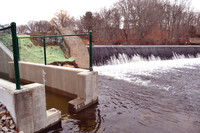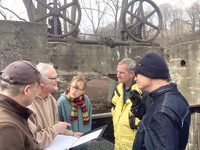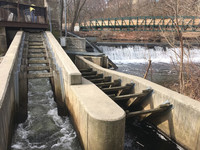For the first time in roughly 150 years, herring and other important saltwater fish may be returning to Johnston, and volunteers with the Woonasquatucket River Watershed Council (WRWC) are preparing to count them to see if their habitat
This item is available in full to subscribers.
We have recently launched a new and improved website. To continue reading, you will need to either log into your subscriber account, or purchase a new subscription.
If you are a current print subscriber, you can set up a free website account by clicking here.
Otherwise, click here to view your options for subscribing.
Please log in to continue |
|



For the first time in roughly 150 years, herring and other important saltwater fish may be returning to Johnston, and volunteers with the Woonasquatucket River Watershed Council (WRWC) are preparing to count them to see if their habitat restoration efforts are succeeding.
For the past 15 years, the WRWC has planned for and built five fish passageways around dams on the lower Woonasquatucket River for herring and other fish that cannot jump. In December, after nearly three years of construction costing nearly $500,000, an S-shaped, easy to use passage for fish was completed adjacent to the Manton Dam off Goldsmith Street. The fishway opened the river to Manton Pond, and the WRWC believes the river now provides enough habitats for 40,000 spawning herring.
“I like the fish,” said John Hake, fishery biologist and vice president of the board of directors of the WRWC. “I started doing this a few years ago when I retired, and I figured I’d go back to my roots here and get involved. I can’t see any reason why they won’t make it up to Manton.”
After a century of heavy pollution and abuse of the river, fish have once again become a common sight. Herring are anadromous; they live most of their life in the open ocean but need rivers to spawn. After about four years, the fish return to the river in which they were born to reproduce. The Woonasquatucket was recently stocked with herring from other parts of the state, and a population that’s programmed to return to the river is now ready.
“The only herring you’ll get here is the Blueback herring and the Alewife. We also have the possibility of shad, but I don’t think we’ll see shad up here,” said Hake. “We haven’t seen any yet today, it’s a little to early yet. Once we get the water to 50 degrees we should see some, but we’re not quite there yet.”
Last Saturday, volunteers met with Hake behind the Rising Sun Mills in Providence for a fish count training session. There, he provided instructions at the location’s fish ladder on what to look for, how to record observations and answered questions about the fish and the river.
“We usually start April 1 with our counts, but last year we had to start early because it got warm. This year it started getting warm and we got anxious that we should start the count,” said Hake. “If they don’t have a place to spawn, we don’t have any more herring.”
During the next several weeks, volunteers will watch for and count fish as they pass through the river’s first fish ladder. Volunteers were shown how to fill out observation sheets, record water temperatures, and notate the depth of the water passing through the ladder. Collected data are then presented to the state’s biologist, who will then estimate the amount of fish that have traveled upstream. Volunteers were asked to complete at least two observation sessions each day, one in the morning and another in the afternoon.
Hake advised attendees not to count eels and to only count those fish about eight inches long or larger. He said the fish had a tendency to circle the fish ladder exit and to not count the same fish twice.
“We’ve had three good years, and then last year our numbers were down, so we were concerned about that,” said Hake. “We’re hoping for a bounce back this year. The water has gotten a lot better here; it’s cleaner than in the past.”
For more information on the project, visit www.woonasquatucket.org.
Comments
No comments on this item Please log in to comment by clicking here